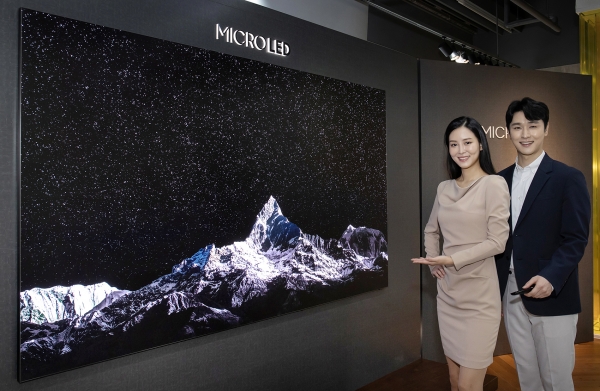
Samsung Electronics is planning to reduce the production steps in its MicroLED TV production to lower their prices, TheElec has learned.
The company will apply RGB(red, green and blue) one chip transfer technology during production.
Samsung currently transfer R, G and B chips separately. Instead, they will implement RGB into one chip. This increases the chips size, making transfer of them on to the printed circuit board relatively easier.
This also reduces the time it takes to transfer the chips on to the PCB, shortening the overall production time and allowing Samsung to improve the yield rate. It also reduces the number of repair process after transfer.
Overall, the reduction of steps and the shortening of production time allows Samsung to save cost, which will lead to the TVs to having lower price tags.
Samsung transferred R, G and B chips separately for the 110-inch MicroLED TV TheWall unveiled in December last year. Over 8 million R, G and B chips were transferred onto the board separately. The company also needed to repair the chips that were damaged during transfer. A 1% defect means 80,000 LED chips had to be swapped. These complications led to the model being priced at 170 million won, or around US$150,000.
Besides the RGB one chip, the tech giant was also considering applying RGBRGB one chip (six pixels into one, or multi die one chip). It was also considering using magnets to align the LED chips. These will be applied after RGB one chip is applied successfully.
Transferring the LED chips onto the board is the biggest challenge in MicroLED production as the chips are micrometers in size.
Samsung launched its first MicroLED TV called the Wall in 2018 aimed at the business-to-business market. Its latest 110-inch The Wall unveiled in December 2020 will be commercially launched in March. The company is also planning to launch a 99-inch version afterwards. MicroLED TV models in the 70 to 80-inch range is also scheduled to launch within the year.
MicroLED doesn’t require a backlight unit or color filters. The LED chips themselves emit light. As it is made from aligning the LED chips, it can be made in various sizes and shapes.
MicroLED TVs will need to become more affordable however. Samsung is planning to ship them aggressively this year. Main rival LG Electronics is pushing OLED TVs and MiniLED TVs to compete.


